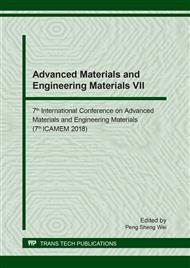[1]
E.Mahdi, O.M.S. Alkoles, A.M.S. Hamouda, B.B. Sahari, R.Yonus, G. Goudah, Light Composite elliptic springs for vehicle suspension, Compos. Struct., 75 (2006) 24-28.
DOI: 10.1016/j.compstruct.2006.04.082
Google Scholar
[2]
S.Mazumdar, Composites Manufacturing: Materials, Product, Process engineering, CRC Press, Boca Raton, (2002).
Google Scholar
[3]
P.K. Mallick, Fiber-Reinforced Composites: Materials, Manufacturing, and Design, third ed., CRC press, Boca Raton, (2007).
Google Scholar
[4]
L.Mohammed, M.N. Ansari, G. Pua, M. Jawaid, M.S. Islam, A review on natural fiber reinforced polymer composite and its applications. Int. J. Polym. Sci., (2015).
DOI: 10.1155/2015/243947
Google Scholar
[5]
S.Y. Nayak, N.M. Amin, S.S. Heckadka, V.Shenoy, C.S. Prakash, R.Mabbu. Design, Fabrication and Testing of Carbon Fiber Reinforced Epoxy Drive Shaft for All Terrain Vehicle using Filament Winding, In MATEC Web of Conferences, 153(2018) 04010.
DOI: 10.1051/matecconf/201815304010
Google Scholar
[6]
C.Qian, W.Shi, Z.Chen, S.Yang, Q.Song, Fatigue reliability design of composite leaf springs based on ply scheme optimization, Compos. Struct., 168 (2017) 40-46.
DOI: 10.1016/j.compstruct.2017.02.035
Google Scholar
[7]
A.R.A. Talib, A.Ali, G.Goudah, N.A.C. Lah, A.F. Golestaneh, Developing a composite based elliptic spring for automotive applications, Mater. Des., 31 (2010) 475-484.
DOI: 10.1016/j.matdes.2009.06.041
Google Scholar
[8]
Y.Yamada, T.Kuwabara (Eds.), Materials for springs. Springer Science & Business Media, Tokyo, (2007).
Google Scholar
[9]
H.A.Al-Qureshi, Automobile leaf springs from composite materials, J. Mater. Process. Technol., 118 (2001) 58-61.
Google Scholar
[10]
S.Rajesh, G.B. Bhaskar, J.Venkatachalam, K.Pazhanivel S.Sagadevan, Performance of leaf springs made of composite material subjected to low frequency impact loading, J. Mech. Sci. Technol., 30 (2016) 4291-4298.
DOI: 10.1007/s12206-016-0842-x
Google Scholar
[11]
M.Sureshkumar, P.Tamilselvam, R.Kumaravelan, R.Dharmalingam, Design, fabrication, and analysis of a hybrid FIBER composite monoleaf spring using carbon and E-glass fibers for automotive suspension applications, Mech. Compos. Mater., 50 (2014).
DOI: 10.1007/s11029-014-9398-y
Google Scholar
[12]
J.T.J. Kueh, T.Faris, Finite element analysis on the static and fatigue characteristics of composite multi-leaf spring, Journal of Zhejiang University SCIENCE A, 13 (2012)159-164.
DOI: 10.1631/jzus.a1100212
Google Scholar
[13]
L.Thippesh, Fabrication of Hybrid Composite Mono-Leaf Spring with Unidirectional Glass Fibers, Materials Today: Proceedings, 5 (2018) 2980-2984.
DOI: 10.1016/j.matpr.2018.01.096
Google Scholar
[14]
J.Wang, Z.Li, Q.Jiang, The analysis of composite leaf spring by finite element method and experimental measurements, In Proceedings of the FISITA 2012 World Automotive Congress, Springer, Berlin, 2013, pp.823-829.
DOI: 10.1007/978-3-642-33835-9_74
Google Scholar
[15]
M.M. Shokrieh, D.Rezaei, Analysis and optimization of a composite leaf spring, Compos. Struct., 60 (2003) 317-325.
DOI: 10.1016/s0263-8223(02)00349-5
Google Scholar
[16]
Information on https://www.atul.co.in (Last Accessed in May 2017).
Google Scholar
[17]
E.Sancaktar, M.Gratton, Design, analysis, and optimization of composite leaf springs for light vehicle applications, Compos. Struct., 44 (1999) 195-204.
DOI: 10.1016/s0263-8223(98)00136-6
Google Scholar
[18]
S.A. Paul, A.Boudenne, L.Ibos, Y.Candau, K.Joseph, S.Thomas, Effect of fiber loading and chemical treatments on thermophysical properties of banana fiber/polypropylene commingled composite materials, Compos. Pt. A-Appl. Sci. Manuf., 39 (2008).
DOI: 10.1016/j.compositesa.2008.06.004
Google Scholar
[19]
ASTM D7264 / D7264M-15, Standard Test Method for Flexural Properties of Polymer Matrix Composite Materials, ASTM International, West Conshohocken, PA, (2015).
Google Scholar


